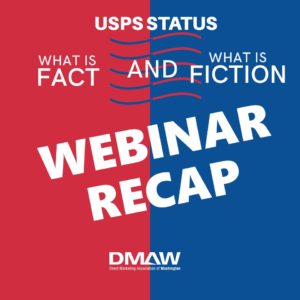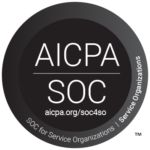Our colleague Debbie Sylvester of MailSmart Logistics was one of five expert panelists reporting on mail tracking data and sharing insights during this week’s DMAW “USPS Status: What is Fact and What is Fiction” webinar.
 The key findings conveyed by all the panelists:
The key findings conveyed by all the panelists:
- Mail tracking data across hundreds of mailers and hundreds of millions of mail pieces indicates that average delivery times have not changed.
- Pandemic-related delays over the past several months have now abated and are improving. First-Class Letter Mail and Marketing Mail delivery are performing consistently, with delivery slowed by just a half-day or one day at most, when comparing monthly and annual trends, including election years.
- Flats, such as catalogs, magazines, and larger envelopes are experiencing delays with inconsistent delivery times.
- Inbound reply mail is experiencing some slowing.
The panelists shared valuable tips for nonprofits planning their fall mailings during this busy election and fundraising season:
- Track your own mail! Your own mailing data is more helpful than relying on media coverage, anecdotal evidence, or even USPS data.
- Tracking your outbound mail is the top priority, but if you can, also track your inbound mail. Tracking can help you with revenue forecasting and cross-marketing efforts.
- Debbie Sylvester noted that 90+% of commingled mail goes directly to the Destination SCF (Sectional Center Facility), skipping four USPS steps: the local post office where your mail shop is located, the Origin SCF, the Origin NDC (Network Distribution Center) and the Destination NDC, which expedites delivery, is more predictable, and saves money.
- Debbie also explained that Drop Shipping your mail to Destination SCFs and NDCs is another potential solution depending on the geographic density and volume of your mailings. Your postal logistics partner can analyze each mailing and recommend the best approach. In some cases, the best solution may be a hybrid plan, including both commingling and drop shipping.
- Moderator Mike DeFlavia, Vice President of Production, at Lautman Maska Neill & Company remarked that it’s not necessary for fundraisers to know all these technical details. Your agency, production, and postal logistic partners can provide expert guidance on what’s best for your individual mailings and your overall program.
- Business Reply Mail is sometimes delayed when it gets to its destination due to accounting unit processing delays at your local post office. Contact your local Post Office to inquire.
- We will see large volumes of political mail in the weeks and months ahead, especially in swing states. So plan ahead and work with your partners on your campaign schedules and mailing strategy.
Steve Kearney, Executive Director of the Alliance of Nonprofit Mailers, who spent over 35 years at the USPS in leadership positions, cut through the media clutter with accurate information about postal operations and funding.
- The Postal Service can handle mail volumes during election season, including vote-by-mail correspondence, which is a tiny percentage of overall mail volume.
- The pandemic has impacted postal employee availability in Covid-19 hot spots; certain areas are experiencing service delays due to absenteeism.
- Steve Kearney noted that given the volume of daily mail processed through the USPS, anecdotal evidence of delays, often covered in the media, is not reflective of the overall service levels which are well within established delivery standards.
- The new Postmaster General Louis DeJoy is committed to maintaining service levels, prioritizing election mail, and is delaying any proposed changes until after the election.
Mike DeFlavia wrapped up the discussion by stating that direct mail continues to be a critical channel for nonprofits, and nonprofits should move forward with their plans for the fall and year-end. 33% of charitable giving is done in the last three months of the year, according to the 2019 Charitable Giving Report from The Blackbaud Institute. And for many nonprofits, direct mail continues to be the largest source of donation revenue.
If you have any questions about the USPS, mail tracking and deliverability trends, and your fall mailing program, please contact us. We’re happy to help and share our insights.



